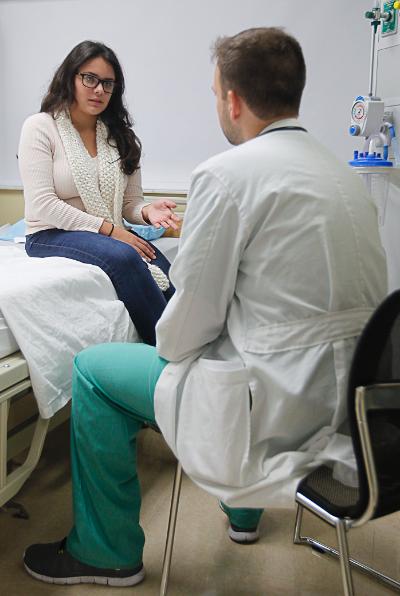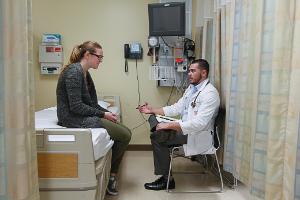Ms. Rubin averts her eyes, afraid to hear what the doctor has to say. She’s just returned to her job as a high-school math teacher, after surgery and an aggressive course of chemotherapy to treat colon cancer. The last two weeks, however, she has felt more tired than ever before, with bouts of severe abdominal pain.
Her doctor attends to her diligently. He asks questions and reviews the results of her CT scan. After a 10-minute consultation, he has bad news for Ms. Rubin: her cancer has spread to her liver.
And … cut!
 |
| Alexis Rondon portrays “Ms. Rubin” during her final exam for the Standardized Patient Training course. |
Ms. Rubin is not a real person. She is the fictional patient played by students taking their final exam for Standardized Patient Training, a unique collaboration between the College of Arts & Sciences Department of Theatre Arts, the Miller School of Medicine, and the School of Nursing and Health Studies.
Standardized patients (SPs) are healthy people who have been trained to realistically portray a fictionalized patient in order to help medical and nursing students hone their diagnosis skills and their clinical manner. They are an important tool for medical education.
SPs learn to communicate the fictionalized patient’s medical history, subtext, personality, physical infirmities, and emotional state to medical students – using improvised dialogue and physical movement.
The Standardized Patient Training class is designed to provide an introduction to the acting skills and physiological knowledge needed to become an effective standardized patient – and to help students in various fields to hone their interpersonal skills. Although it is offered through the Department of Theatre Arts, pre-health students could take the class to learn more about “the other side” of the healthcare equation.
Maha McCain, a faculty member in the College of Arts & Sciences Department of Theatre Arts who teaches acting, directs the course.
“SP work isn’t a performance – it’s an interactive experience, with all participants knowing that they are playing along with a fictional scenario,” she said, adding that the “patient” and the student move through the scene together “to practice the dynamics of interpersonal communication.”
She likens standardized patient work to improvisational theatre. “You’re given pieces of information that act as inspiration to develop your character, relationship to other characters, and your environment, but you and a partner have to make up the actual dialogue. Working like that requires an intense amount of focus and creativity to make the interaction look and feel as believable and natural as possible.”
For the final, students enrolled in Standardized Patient Training memorized a six-page document containing the patient history for “Mr./Ms. Rubin.” It is incredibly detailed, noting (among other information) that the patient owns a cat, had a tonsillectomy at age nine, and takes vitamins daily.
Each student participated in two one-on-one sessions with a volunteer medical student, who evaluated their words, gestures, facial expressions and other non-verbal cues. They looked for a convincing portrayal of the patient, and for consistency between the two sessions.
“It has to be standardized,” said Stephen Di Benedetto, chair of the Department of Theatre Arts.
Alexis Rondon is a sophomore English major, minoring in theatre, who is pursuing the pre-health track.
She said the class helped her hone her improvisational skills. “You can’t just go in with the information from the case history,” she said. “You have to be the character, and give it real depth. Make them 3D, not 2D.”
She added, “You give it your personal flair, but you need to be true to what the person was actually going through.”
The exams took place in the nursing school’s state-of-the art M. Christine Schwartz Center for Nursing Education. Students and their “doctors” met in startlingly realistic models of emergency rooms, and all sessions were recorded for later review by McCain. Susana Barroso-Suarez and Noel Irias from the nursing school graciously made the facilities available to the class.
 |
| Casey McGillicuddy portrays “Ms. Rubin” during her final exam for the Standardized Patient Training course. |
Di Benedetto said, “This is an extraordinary interdisciplinary collaboration in the conception and execution of a novel form of theatre training.”
He added that there are five regional medical training centers that employ professional standardized patients, a potentially untapped job market for theatre arts graduates.
The course was the brainchild of Dr. Alex Mechaber, senior associate dean for undergraduate medical education and associate professor of medicine at the Miller School of Medicine.
“Several schools around the country have employed professional actors in their SP programs. I thought it would be unique to train theatre arts students for these roles while helping to provide a service for our medical students,” he said.
Mechaber added, “Effective SPs are ones who can truly simulate real patient scenarios, mimicking patients seen in the clinical environment. Accurate portrayal of patients is a crucial element.”
The United States Medical Licensing Examination Step 2 Clinical Skills Exam – which all future doctors are required to pass – uses standardized patients to evaluate students’ “bedside manor.”
McCain said, “The goal is to help the med personnel treat the patient as a respected and valued individual, and to be receptive to the patient’s emotions, whether spoken or expressed non-verbally (physically).”
She teaches the course on the Coral Gables campus. Dr. S. Barry Issenberg – director of the Michael S. Gordon Center for Research in Medical Education, associate dean for research in medical education and the Michael S. Gordon Professor of Medicine and Medical Education – and Assistant Director of Curriculum and Technology Development Dr. Hector Fabio Rivera met regularly with McCain to bring the medical perspective to the class. Dr. Rivera and Dr. Ross Scalese, assistant director of research and technology at the Gordon Center, served as guest lecturers for the class.
Dr. Rivera called the final exercise “a reverse OSCE” (objective structured clinical evaluation) – since the medical students were evaluating the SPs.
“From the perspective of the patients, the students understand why certain questions are being asked,” he said. “They can learn what to expect from their physician or health-care provider.”
He added that pre-health students can gain unique and valuable insights into the training they will receive at the graduate level in medical school.
The introductory Standardized Patient Training Class will be offered each fall semester, and an intermediate course will be available each spring.
Di Benedetto said, “We hope that the class will appeal to students across programs so that they can fulfill general education requirements at the same time as gaining exposure to medical training exercises.”
He added that he expects to broaden the partnership between the College’s Theatre Arts Program and the Schools of Medicine and Nursing to develop additional joint offerings. “This collaboration allows us to offer a broad range of students an exposure to the ways in which performance training can be used in other fields. It provides us with the opportunity to demonstrate that art and science can collaborate in innovative ways that are beneficial to both disciplines.”
January 05, 2015

